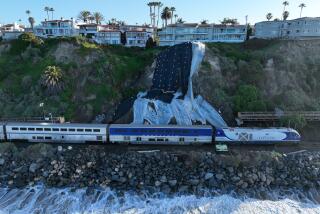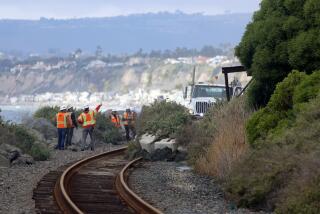Trolley Car, With Some TLC, May Return to Fare Condition
- Share via
When the San Diego Electric Railway Assn. acquired one of the city’s original trolley cars for $850 last year, it had no idea that the 1936 President Conference Committee model might one day return to public service.
According to Eric Sanders, he and his fellow railway association board members also could not have imagined that the car would serve as an unofficial shelter for the homeless--and then as a target of vandalism when the association and the city stopped its unauthorized use by transients.
The trolley car--which was the first of its type in the Western United States--now sits on a fenced-off Metropolitan Transit Development Board railroad siding at 8th Avenue and Harbor Drive, its inside shell heavily damaged by smoke. According to Lyle Judd of the railway association, authorities believe vandals set fire to the car earlier this year after a fence was put around it to keep the homeless from using it as a makeshift shelter.
Now the railway association is hoping to convince National City officials to use the car for a one-mile bayfront line in the city’s old town.
PCC No. 502, one of the earliest trolley cars made, and 27 others arrived in San Diego in 1936 when the city purchased them from the St. Louis Car Co. The cars remained in operation until the San Diego Electric Railway Co. (later the San Diego Transit Co.) discontinued trolley service in the city in 1949, according to Sanders.
No. 502 was placed in storage for about a year, according to Judd, and then was sold with 18 other cars to an El Paso firm that used it to make trips across the U.S.-Mexican border.
The San Diego Electric Railway Assn., an organization of about 80 trolley enthusiasts, bought the car at auction a little more than a year and a half ago for $850, with nothing more than restoration in mind, Judd said.
According to Bruce Coons, treasurer of the association, “Since then, interest has been expressed in operating the PCC in National City,” although the group has not received conceptual approval from city officials.
“Ideally, the PCC trolley would operate on about one mile of track along the bayfront in the old town area of National City once it is restored,” Sanders said. “Now we’re uncertain how long it’s going to take us to restore the car because of the fire.”
Even if National City doesn’t agree to the bayfront idea, the railway association will attempt to raise funds for restoration.
“This is the last of the old-time trolley cars, so it has some historical significance,” Sanders said. “A lot was put into tracking one of the originals down and bringing it back to San Diego.”
Sounding somewhat regretful, Sanders recalled how the older, much lighter and faster trolley system served by the PCC was replaced by buses.
“I often wondered why San Diego didn’t do as San Francisco and just merge the old trolley system with modern technology, instead of replacing it,” he said.
More to Read
Sign up for Essential California
The most important California stories and recommendations in your inbox every morning.
You may occasionally receive promotional content from the Los Angeles Times.










